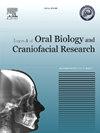不同姜黄素浓度对人牙周韧带成纤维细胞在牙周根表面粘附和增殖的影响:体外研究
Q1 Medicine
Journal of oral biology and craniofacial research
Pub Date : 2025-04-28
DOI:10.1016/j.jobcr.2025.04.006
引用次数: 0
摘要
牙周病内毒素渗透到牙根表面,阻止细胞粘附到牙表面。天然存在的姜黄素具有抗炎、抗氧化和抗菌的特性,通过增加成纤维细胞的增殖和迁移,以浓度依赖的方式促进伤口的快速愈合。目的研究0.12%、1%和2%姜黄素浓度对牙周病根表面PDL细胞粘附、增殖和活力的影响。材料与方法将20颗患牙周的牙齿切分成牙根标本。从新鲜拔牙中收集PDL成纤维细胞,进行培养和扩增。将PDL成纤维细胞(1 × 105个/ml)播种于不同浓度姜黄素包被的根样品上。研究样本分为4组:G1(0.12%姜黄素膏)、G2(1%姜黄素膏)、G3(2%姜黄素膏)和G4(对照组/非条件组)。所有样品均采用扫描电镜(SEM)和MTT法进行检测。结果与其他组相比,g3组的细胞活力和增殖能力最高,而其他组的细胞结构清晰,多层贴壁细胞覆盖整个表面,细胞质延伸很长,几乎没有细菌定植。结论2%姜黄素对牙周炎牙根表面的细胞附着、生长、增殖及抗菌作用均有较好的刺激作用。本研究中最佳姜黄素浓度的测定显示,2%浓度的姜黄素可在牙周炎患者牙根表面产生最高水平的PDL细胞附着、活力、增殖和抗菌作用。因此,使用最佳姜黄素浓度作为非手术牙周治疗的辅助可能会改变牙周袋生态,以改善牙周组织的愈合。本文章由计算机程序翻译,如有差异,请以英文原文为准。

Effects of different curcumin concentrations on human periodontal ligament fibroblast adhesion and proliferation on periodontally involved root surfaces: In-vitro study
Introduction
Periodontopathic endotoxins infiltrate root surface and prevent cellular adhesion to tooth surfaces. Naturally occurring curcumin has anti-inflammatory, antioxidant and antibacterial qualities that promote fast wound healing by increasing fibroblast cell proliferation and migration in concentration-dependent manner.
Objectives
This study was conducted to evaluate the effect of 0.12 %, 1 % and 2 % curcumin concentrations on PDL cell adhesion, viability and proliferation to periodontally affected root surfaces.
Materials and methods
20 periodontally affected teeth sectioned into root samples were included. PDL fibroblasts were collected from freshly extracted teeth, cultured and expanded. PDL fibroblast (1 × 105 cells/ml) was seeded on curcumin coated root samples in different concentrations. Study samples were divided into 4 groups: G1 (0.12 % of curcumin paste), G2 (1 % curcumin paste), G3 (2 % curcumin paste) and G4 (control/unconditioned group). All samples were investigated by SEM and MTT assay.
Results
G3 showed highest viability and cell proliferation compared to other groups where well defined multilayered adherent cells covering entire surface with totally flat polyhedral bodies with long cytoplasmic extensions and little or no bacterial colonization.
Conclusion
Curcumin 2 % provides optimal stimulation of cellular attachment, viability, proliferation and antibacterial effects over periodontitis affected root surfaces.
Clinical relevance
Determination of optimal curcumin concentration in this study revealed 2 % concentration produced highest levels of PDL cellular attachment, viability, proliferation and antibacterial action over root surfaces afflicted by periodontitis. Therefore, the use of that optimal curcumin concentration as adjunctive to non-surgical periodontal therapy may modify the periodontal pocket ecology to improve the healing of periodontal tissues.
求助全文
通过发布文献求助,成功后即可免费获取论文全文。
去求助
来源期刊

Journal of oral biology and craniofacial research
Medicine-Otorhinolaryngology
CiteScore
4.90
自引率
0.00%
发文量
133
审稿时长
167 days
期刊介绍:
Journal of Oral Biology and Craniofacial Research (JOBCR)is the official journal of the Craniofacial Research Foundation (CRF). The journal aims to provide a common platform for both clinical and translational research and to promote interdisciplinary sciences in craniofacial region. JOBCR publishes content that includes diseases, injuries and defects in the head, neck, face, jaws and the hard and soft tissues of the mouth and jaws and face region; diagnosis and medical management of diseases specific to the orofacial tissues and of oral manifestations of systemic diseases; studies on identifying populations at risk of oral disease or in need of specific care, and comparing regional, environmental, social, and access similarities and differences in dental care between populations; diseases of the mouth and related structures like salivary glands, temporomandibular joints, facial muscles and perioral skin; biomedical engineering, tissue engineering and stem cells. The journal publishes reviews, commentaries, peer-reviewed original research articles, short communication, and case reports.
 求助内容:
求助内容: 应助结果提醒方式:
应助结果提醒方式:


